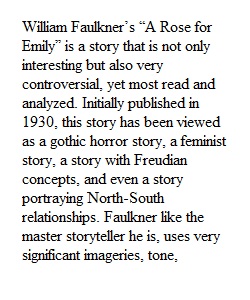


Q The fourth essay genre is particularly important in the field of English: the literary analysis. This genre of essay closely reads a work of literature and makes an interpretive statement about it to… …argue for a particular meaning; …highlight a theme, character, plot feature, or aspect of setting; …show how it interacts with its historical, cultural, or religious context; …or suggest that it helps us understand a larger idea or phenomenon in the world. For this particular literary analysis, you do not need to perform outside research but you do need to quote directly from the chosen text to support your perspective. This perspective should be given in a clear thesis statement, usually at the end of the first paragraph. You will analyze one of the five works of literature in the textbook: Faulkner’s “A Rose for Emily,” Dove's "The First Book," Gilman's "The Yellow Wallpaper, Hughes' "Theme for English B," or Dickinson’s “A word is dead.” Your essay will be evaluated according to the following Key Features: An arguable thesis Careful attention to the language of the text A clear interpretation Attention to patterns or themes
View Related Questions